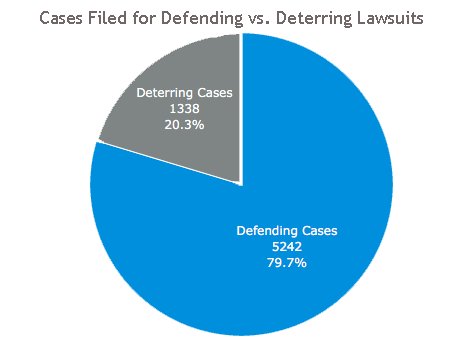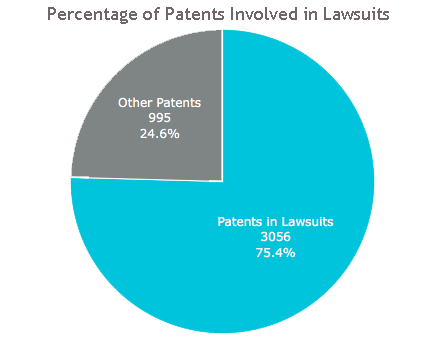Patexia Insight 44: Eighty Percent of IPR Filings are for Defensive Purposes
Inter-Partes Review (IPR) is known as an effective, relatively low cost (compared to district court litigation) and quick method used by defendants as a defense strategy in district court cases. This week, we analyzed the cases to see what percentage of cases are directly related to active cases in district courts. Out of 6,580 IPR challenges filed from 2012 through the end of the second quarter in 2017, we found that about 80 percent had been filed while the challenged patent was already in an active district court case. We also looked at the number of unique patents that had been challenged for litigation deterrence or reasons other than response to a district court case.

Out of 6,580 IPR cases, 1338 or approximately 20 percent had been filed to challenge a patent that had not been named in any district court cases. Patexia tracks all the district court cases as well as PTAB cases. We compared the patents challenged in IPRs with all patents named in district court cases since 2010 to see how many of them have been named in both PTAB and district court cases. Based on our data collected from PTAB and PACER, we found that 20 percent of IPRs have been filed without an existing district court case. This means the petitioners had reasons other than an alternative defense method for a pending lawsuit. Some of the known reasons for these challenges include:
- Leverage in licensing / acquisition negotiations - when patent owners approach a company and ask them to license a portfolio, often times portfolio has hundreds of patents but only a handful of them are the drivers in a deal. These patents may be accompanied by a claimchart or relevant information that supports the reasons behind the deal and why the company needs a license. Challenging and eventually damaging the crown jewels of a portfolio can give the potential licensee an upper hand in negotiation and if successful, can substantially drive the price down.
- Attacking a non-practicing entity (NPE): As an indirect response to lawsuits filed by an NPE, in some cases, a different patent may be challenged by a defendant or an entity representing a defendant to both hurt the patent owner’s portfolio (NPE) and also divert their resources or cause distraction.
Since patents may be challenged multiple times by different organizations, we decided to look into unique patents and see the ratio of those patents challenged for defensive purposes versus those challenged for other reasons (deterrence). We found that only 4,051 unique patents had been challenged in all 6,580 cases. And about ¾ of patents had already been named in one or more district court cases. This means that out of every four IPR cases, one is filed for a reason other than defense. We listed couple of reasons a petitioner may decide to file a case. If you are aware of other reasons, please share your thoughts with us.

In late September, we released IPR Intelligence, our first report from IP Insights series, where we reviewed 6,580 IPR cases filed from 2012 through the end of the first half in 2017 and provided many different statistical charts about IPR at the case, patent and claim levels. We also calculated the performance and activities of more than 1,000 law firms and 5,000 attorneys in 6580 IPR cases. The report has received positive reviews and thanks to our partners, we are in the process of updating the site with more advanced tools for performance measurements and also preparing a similar report for district court litigation in 2018.
In the coming weeks, we will release the names and performance of some of the best performing law firms that have been named among Patexia Top 50 law firms in different IPR categories. Stay tuned...